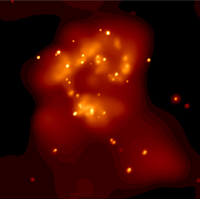August 16, 2000
CXC PR: 00-21
Like children blowing bubbles on the front porch steps, the merging Antennae Galaxies in constellation Corvus are producing massive bubbles of expanding X-ray-emitting gas at such astonishing rates that they are bumping into each other, forming "superbubbles" -- and surprising astronomers with their sheer numbers and X-ray luminosity.
Drs. Giuseppina Fabbiano, Andreas Zezas and Stephen Murray of Harvard-Smithsonian Center for Astrophysics used NASA's Chandra X-ray Observatory to capture in unprecedented detail this phenomenon that is anything but child's play. In a talk presented today at the General Assembly of the International Astronomical Union in Manchester, UK, Fabbiano said that the observations provide a nearby example of the what it was like fifteen billion years ago when our universe was young and galaxies were just forming.
"Galaxies were much closer together then," explained Fabbiano. "Collisions like the ones that produced the Antennae were much more common, and played a major role in shaping the galaxies we see around us today."
The Antennae Galaxies, about 60 million light years from Earth (in the constellation Corvus), are two colliding and visually stunning galaxies named NGC 4038 and NGC 4039. They acquired their nickname from the wispy, antennae-like streams of gas caused by their merging, seen by early optical telescopes.
Many astronomers believe our own Milky Way galaxy is the product of a merger. While galaxies may collide, the stars contained within usually do not, because stars comprise only a small fraction of the space within a galaxy. However, during a hundred-million-year collision, that makes the movement of glaciers look like a lightning bolt, one galaxy can pull the other apart gravitationally. Shock wave compression of massive clouds of gas and dust can lead to the rapid birth of millions of stars.
The explosion of these stars a few million years later creates thousands of supernova remnants–bubbles of multimillion degree Celsius gas enriched with oxygen, iron and other heavy elements. These expanding bubbles, collide and coalesce to form superbubbles that are five thousand light years in diameter.
Earlier data from the Rosat X-ray observatory showed extended patches of X-ray light in the Antennae, but according to Fabbiano, "We didn't know for sure that the superbubbles existed." Now scientists know that in addition to the superbubbles, the Antennae contain dozens of bright point-like sources– neutron stars and black holes-- left behind by the flurry of supernova activity. The X-rays from these sources are generated by gas that is heated to tens of millions of degrees Celsius as it streams from nearby companion stars onto neutron stars or into black holes.
The ability to observe the neutron star/black hole sources and the superbubbles in the Antennae will enhance astronomers' understanding of the evolution of galaxies over the eons through the interplay of galaxy collisions, star formation, gravity and supernovas.
"What we are witnessing with Chandra is galaxy ecology in action," said Andreas Zezas, "Over tens of millions of years, the superbubbles gradually enrich the galaxy's supply of oxygen and other elements, and may provide the energy needed to trigger the collapse of more clouds to form more stars and more supernovas in a continuing cycle of star birth, death and renewal." The next step will be to pin down the temperature and energy content more exactly, and to determine how much iron and other heavy elements are in the bubbles, and do some statistics based on the number of bubbles to refine the "galactic ecology."Chandra observed the Antennae with the Advanced CCD Imaging Spectrometer (ACIS) for 20 hours on December 1, 1999.
The ACIS instrument was built for NASA by the Massachusetts Institute of Technology, Cambridge, and Pennsylvania State University, University Park. NASA's Marshall Space Flight Center in Huntsville, Ala., manages the Chandra program. TRW, Inc., Redondo Beach, Calif., is the prime contractor for the spacecraft. The Smithsonian's Chandra X-ray Center controls science and flight operations from Cambridge, Mass.
To follow Chandra's progress, visit the Chandra site at:
MEDIA CONTACTS
Steve Roy
Marshall Space Flight Center, Huntsville, AL
Phone: 256-544-6535
Dr. Wallace Tucker
Chandra X-ray Observatory Center, CfA, Cambridge, MA
Phone: 617-496-7998



